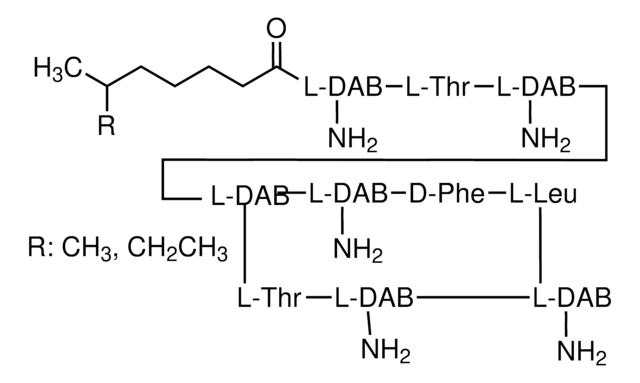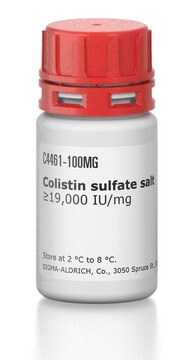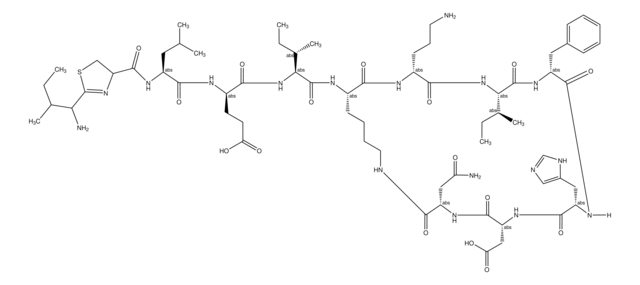P1004
Polymyxin B sulfate salt
Sinonimo/i:
Polymixin, Polymixin B, Polymixin B sulfate
About This Item
Prodotti consigliati
Origine biologica
Pseudomonas aeruginosa
Livello qualitativo
Stato
powder
Condizioni di stoccaggio
(Tightly closed. Dry. )
Solubilità
water: 50 mg/mL
Spettro attività antibiotica
Gram-negative bacteria
fungi
Modalità d’azione
cell membrane | interferes
Temperatura di conservazione
2-8°C
Stringa SMILE
O=C(C(NC(C(CCN)NC(CCCCC(C)CC)=O)=O)C(C)O)NC(CCN)C(NC(CCNC(C(NC(C(NC(C(CCN)N1)=O)CCN)=O)C(O)C)=O)C(NC(CCN)C(NC(CC2=CC=CC=C2)C(NC(CC(C)C)C1=O)=O)=O)=O)=O.O=S(O)(O)=O
InChI
1S/C48H82N16O13.H2O4S/c1-27(2)24-37-47(76)59-32(11-19-52)41(70)56-31(10-18-51)43(72)61-35(14-22-65)39(68)54-21-13-34(45(74)57-33(12-20-53)44(73)64-38(48(77)63-37)25-28-6-4-3-5-7-28)60-42(71)30(9-17-50)58-46(75)36(15-23-66)62-40(69)29(8-16-49)55-26-67;1-5(2,3)4/h3-7,26-27,29-38,65-66H,8-25,49-53H2,1-2H3,(H,54,68)(H,55,67)(H,56,70)(H,57,74)(H,58,75)(H,59,76)(H,60,71)(H,61,72)(H,62,69)(H,63,77)(H,64,73);(H2,1,2,3,4)
HNDFYNOVSOOGDU-UHFFFAOYSA-N
Cerchi prodotti simili? Visita Guida al confronto tra prodotti
Descrizione generale
Applicazioni
- in human aortic endothelial cells (HAEC) cell culture to exclude potential endotoxin contamination in recombinant adiponectin
- in the analysis of the isolates
- in endotoxin-neutralizing activity of α-amylase (AmyI-1)-18 (LAL assay)
Azioni biochim/fisiol
Antimicrobial spectrum: Has bactericidal action on most gram-negative bacilli††, including E. Coli and on most fungi and gram-positive bacteria.
Caratteristiche e vantaggi
Nota sulla preparazione
Stock solutions should be sterile filtered and stored at 2-8°C. They are stable at 37°C for 5 days.
Stoccaggio e stabilità
Altre note
Avvertenze
Warning
Indicazioni di pericolo
Consigli di prudenza
Classi di pericolo
Acute Tox. 4 Oral
Codice della classe di stoccaggio
11 - Combustible Solids
Classe di pericolosità dell'acqua (WGK)
WGK 3
Punto d’infiammabilità (°F)
Not applicable
Punto d’infiammabilità (°C)
Not applicable
Dispositivi di protezione individuale
dust mask type N95 (US), Eyeshields, Gloves
Scegli una delle versioni più recenti:
Certificati d'analisi (COA)
Non trovi la versione di tuo interesse?
Se hai bisogno di una versione specifica, puoi cercare il certificato tramite il numero di lotto.
Possiedi già questo prodotto?
I documenti relativi ai prodotti acquistati recentemente sono disponibili nell’Archivio dei documenti.
I clienti hanno visto anche
Il team dei nostri ricercatori vanta grande esperienza in tutte le aree della ricerca quali Life Science, scienza dei materiali, sintesi chimica, cromatografia, discipline analitiche, ecc..
Contatta l'Assistenza Tecnica.







